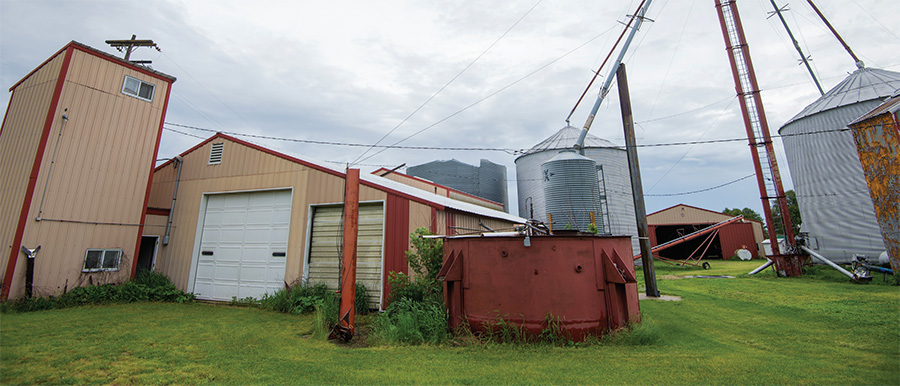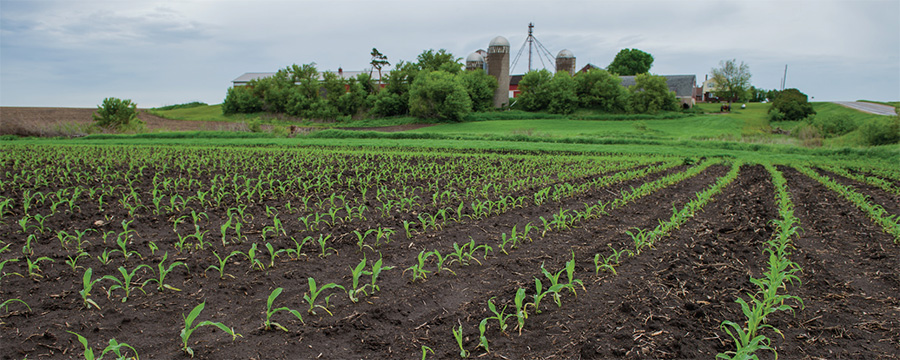The origin of powered flight feeds into a can-do American spirit.
With the contents of their bicycle shop, an untutored knack for design and imagination, the Wright brothers got man off the ground.
The history of POET parallels this spirit. In the early 1980s, Lowell Broin, family members, neighbors and a handful of ethanol pioneers learned what was needed to later drive the creation of a contemporary biofuels giant from a toolbox of skills similar to the Wrights’.
POET Executive Chairman Jeff Broin says of his father, “he was not a carpenter, but he never let that stop him from building everything from the house my brothers, sister and I grew up in to the silos that stood tall on our farm. He built a 40-stall block dairy barn mostly by himself.” Lowell Broin “relied on his common sense and creativity to get the jobs done and done right,” his son says. His father’s embodiment of the American entrepreneurial spirit is the foundation POET is built on. It guided his sons and is at the heart of POET’s success.
As the country was emerging from the farm crisis of the late 1970s, corn was selling for less than what it cost to grow. On the family farm near Wanamingo, MN, Lowell and Judy Broin and their children Rob, Cindy, Jeff and Todd milked cows, farrowed sows, grew crops and chafed at the fact the greatest revenue from productive farmland was often a federal payment to keep it out of production.
“The government was paying to leave land idle. Why should we leave it idle?” Lowell says.
At the same time a growing realization that we were too reliant on foreign oil drove farmers and legislators to come together to create a new industry. Henry Ford had advocated ethanol as a motor fuel from the beginning of the 20th century. Over the years it offered tantalizing but unfilled hope it could become the next big value added commodity for corn growers. Its value as a replacement for gasoline brought new attention to it.
“We were looking at a way to make a little extra money on the farm,” says Lowell. “There were already some ethanol plants built, but none of them were making it profitably. We figured out a way to make it work.”
The successful formula was to start slow, proceed carefully and bring the family’s talents to bear.
Over the course of several years, the Broins built a distillery capable of producing about 250,000 gallons of ethanol.
Oldest son Rob “went to school to learn the chemistry part of it,” his father says.
“My wife would look through the want ads for used tanks and distilling equipment.”
Sons Jeff and Todd studied agricultural business and computer technology in college, respectively.
Family lore has Lowell working out the principles of distilling ethanol in a pressure cooker on the kitchen stove.
It might have happened.
“That’s what they tell me. The kids tell me we did that one time,” he says. He does remember “we had to mix sulfuric acid in the mash to make it ferment right. I always had holes in my clothes because of the acid.”
An enduring recollection is working with Rob and a neighbor, Ray Schoenfelder, to build the original distillery. Those were good times.
Schoenfelder, “a mechanical genius,” according to Lowell, rented a house from the Broins.
He was working as a Mercedes auto mechanic and taking vocational education classes in design and fabrication in Rochester, MN.
“Lowell knew that,” says Schoenfelder. “That’s where we started to collaborate.”
Making ethanol “was pretty much like distilling anything.” Lowell had the idea. “I just kind of went through the process that it could be done. It was pretty straightforward. Just a matter of how to connect this to that.”
Lowell says “some of the neighbors thought we were crazy.” But in Schoenfelder’s mind “it absolutely made sense.”
The key to making a success of an ethanol venture was not distilling ethanol. “It’s how you get it to the marketplace, bring it to somebody else. That’s what makes a difference. Lowell was a great guy at getting it to the market,” he says.
Dave Vander Griend, now CEO of ICM Inc. in Colwich, KS, played his own part in what seems in review a practically lighthearted venture. Vander Griend was just taking a break from his own career designing ethanol plants when Rob Broin contacted him about the family’s plans to produce ethanol.
“I worked at the Broin farm a couple of months and helped weld it together to make an ethanol plant,” Vander Griend says. “I ate dinner with the family and even slept in the farm house.”
Ethanol the Broins produced averaged about 175 proof. It was sold to several existing Minnesota ethanol plants that further refined it to 200 proof.
A wet mash cattle feed was a valuable ethanol production byproduct.
“It was hard to sell, because it was wet. But people wanted to buy it,” Lowell says. The ability to sell feed, in fact, dictated the schedule of the entire ethanol enterprise.
“We ran as much as we could sell feed,” he says.
The Broins own dairy cattle became fond of another byproduct, the ironically named “sweetwater.”
“It was the sourest stuff you can imagine, but the cattle loved it. We had a tank by the bunk feeder. We’d haul sweetwater to the cows, and when they saw that out in the pasture they’d come running.”
Pioneers take all the risk. As compensation, however, they have the joy of discovery and the freedom to roam across a new country or an intellectual or economic landscape before it is fenced in by tradition, government regulations and common practice. It may not be readily recognized, but an endearing aspect of the early days of building the ethanol industry is simply “it was a fun thing to do,” says Lowell.
He keeps coming back to that word. “It was a lot of fun. We enjoyed it.”
Deep in the DNA of farmers is a fundamental delight in a good deal. As Lowell sought to produce ethanol without going too far into debt to do it, he happily roamed junkyards and auctions to acquire equipment, often from other ethanol plants that had failed.
“We learned a lot from their mistakes,” he says.
A competitor beat out the Broins for a set of steel tanks at an auction. But when that ethanol venture went under, “they sold the tanks back to us, and they hauled them to the farm for us.” The memory of that good deal still pleases Lowell.
The Broin plant made a great stride toward completion when the family purchased columns needed for the distillery.
“We bought everything we needed at the same place. We happened to find the right junkyard west of the Twin Cities.”
“We didn’t stick a lot of money into it,” Lowell says of his family’s entry into ethanol. This differentiated the Broins from other ventures that did invest heavily. “They had so much stuck into it they had to make a profit right away.”
It was several years before the Broins advanced sufficiently to add on and double the size of the farm plant production. That plant has since been sold and reassembled on a South Dakota farm where it is still in operation, Lowell points out proudly.
One of his few regrets is “we never took enough pictures of everything. People would love to see those pictures.”
Present day image of where the fermentation tanks and distillation towers were located.
Broin Farm
Schoenfelder and Vander Griend were caught up in the spirit of innovation and entrepreneurship as well.
“Absolutely. Anything that’s new is fun to me,” Schoenfelder says of working with the Broins. “You never know where it is going to go until you put something to pencil or machine it, make it. Wow, it’s either better or worse than you thought. But the outcome you never know until you actually do it. That’s the fun part.”
Vander Griend says “it felt like you had an opportunity to make a difference.”
He and Lowell were of like mind about the state of agriculture three decades ago. The lack of value-added commodities resulted in tight government controls on production and purchasing programs to send U.S. grain to third-world countries.
“We were ruining their agriculture and creating more starvation,” according to Vander Griend. For third-world subsistence farmers who make up the majority of the population in those countries, “how do you compete with free food?”
Fulfilling the promise of ethanol to develop substantial new markets for U.S. farmers seemed a worthy quest.
These days, Schoenfelder is CEO of Black Diamond Extreme Engineering, in Cannon Falls, MN. The company develops products and designs prototypes for medical manufacturing and for power sports. His part in helping the Broins
get into the ethanol industry “is basically really close to the beginning of what I do now. I would call it a major building stone. It opened my eyes to design work, prototyping.”
Lowell looks back. “I don’t think anybody could do it like we did. That was luck. We did not push fast. People don’t do that anymore. They have got to get big right away.”
The Broins eventually took their own step in that direction. Looking to buy equipment from a bankrupt ethanol plant in Scotland, SD, the Broins found such a good deal they purchased the entire 1 million gallon facility and decided Rob
would take a break from farming to rebuild the facility and convinced Jeff to move to Scotland to run it. It was the start of POET.
“It has given a lot of people jobs. I’m pleased to see that,” Lowell says of what the Broin venture into ethanol has become.
The ethanol industry has moved beyond him. But he is still on the farm, helping a grandson who has taken over operating it.
For his part in building the renewable fuels industry Lowell says “I never went to any school. It just looked like a lot of fun. The kids would get to figure it out and make it work if I couldn’t. It has made money for them, and now I get to go to Arizona in the wintertime.”











